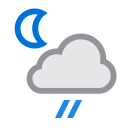Current Weather in Cuenca
 Patchy rain possible
Patchy rain possible9.3°C48.8°F
- Current Temperature: 9.3°C48.8°F
- Current Feels‑Like Temperature: 8.9°C48°F
- Current Humidity: 92%
- Minimum Temperature/Maximum Temperature: 4°C39.3°F / 17.6°C63.6°F
- Wind Speed: 5.4km/h
- Wind Direction: ↑ From the West-Northwest
(Data Time 22:00 / Data Retrieved 2025-09-04 16:45)
Climate‑Related Culture in Cuenca
The cultural and meteorological awareness regarding the climate in Ecuador is deeply rooted in the diverse natural environments and everyday life, as well as traditional events.
Climate Culture of the High Andes
Clothing and Agricultural Rhythm
- A habit of layering wool ponchos and hats according to the temperature difference in the morning and evening.
- In high-altitude areas, the timing for sowing and harvesting is determined according to the rainy season (October to May) and the dry season (June to September).
- Temperature changes are expressed as "chilling" and "drought," utilizing lived knowledge for weather assessment.
Meteorological Awareness of the Pacific Coast
Fisheries and Festivals
- Selection of fishing grounds is based on wave height, tidal flow, and the manner in which shells are washed ashore.
- Carnivals and "Semana Santa" (Holy Week) are held at the end of the dry season, where prayers for abundant catches are performed along the coast.
- It is said that strong south winds (Aurorea) make fish schools more likely to approach the shore, and information is shared among fishermen.
Coexistence with Nature in the Amazon Region
Traditional Weather Forecasting
- Observation of the behavior of birds and insects passed down in tribes is used to interpret the intensity of rain and the arrival of seasons.
- Changes in river water levels serve as a calendar, deciding the timing for fishing and movement.
- The timing of herb and tree budding is connected to health management and rituals.
Tides and Tourism in the Galapagos Islands
Ecosystem and Weather
- Observing rocky areas during low tide is a standard activity to watch the behavior of marine iguanas and penguins.
- Visiting during the dry season (June to November) is comfortable, although the moist north wind (Hammerhead) can become strong.
- To prepare for sudden weather changes, tour guides constantly check the tide tables and cloud movements.
Response to the El Niño Phenomenon
Infrastructure and Preparedness
- In coastal areas that are affected nearly every year, the installation of water tanks and reinforcement of seawalls are ongoing.
- In preparation for abnormal high temperatures and heavy rainfall, a system has been established whereby regional health offices issue "heat stroke and flood warnings."
- Schools have adopted educational materials related to weather disasters and conduct disaster prevention education regularly.
Summary
| Element | Example Content |
|---|---|
| High-altitude Culture | Layered ponchos, sowing and harvesting calendars, lived knowledge of temperature differences |
| Coastal Life | Weather judgment in fishing, sea festivals, tidal flow and prayers for abundant catches |
| Amazon Traditions | Weather forecasting through animal behavior, water level calendars, herbs and health management |
| Tourism and Ecosystem | Low tide observation tours, north wind in dry season, constant checks on tide and cloud movements |
| Modern Preparedness | Seawalls, water tanks, weather warnings, disaster prevention education |
Ecuador's climate awareness is a unique culture that thrives through the fusion of diverse natural environments and the wisdom of its people, from the Andes to the Amazon, and from the coast to the Galapagos.